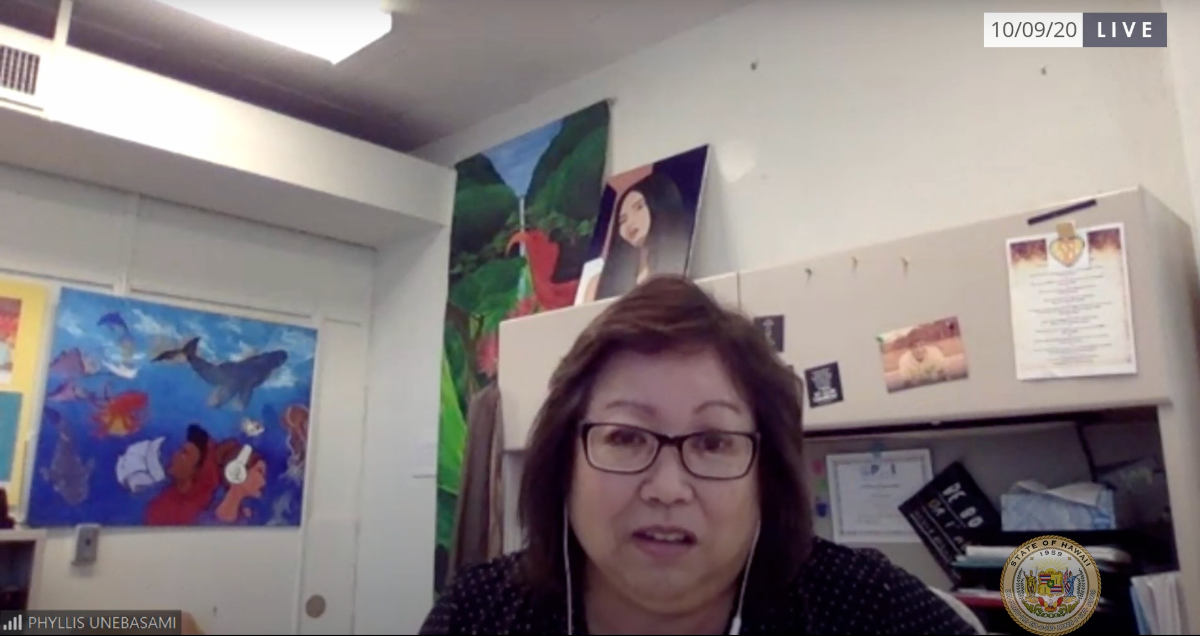Click here to watch this video on YouTube.
After the Hawaii State Department of Health’s school reopening metrics came under intense criticism because, among other things, they were as much as 10 times less stringent than federal metrics, the state epidemiologist told state senators Friday that her department is “looking at coming up with a revised draft of the thresholds.”
Dr. Sarah Kemble told members of the State Senate Special Committee on COVID-19 that she hopes to have a finalized document after next Wednesday’s meeting of the School Health Advisory Committee that’s working through school health standards. The state hopes to have a new document released by the end of next week, Kemble said, assuming the group agrees on changes.
The state is holding weekly meetings of the committee, made up of representatives from the Hawaii Department of Education (HIDOE), including some principals and complex area superintendents, charter and private school principals, as well as health experts looking at that those metrics. HIDOE said the committee includes two teachers. The Hawaii State Teachers Association does not know who those teachers are and was not asked to provide a representative on that committee.
State Sen. Donovan Dela Cruz (D, Mililani Mauka, Waipio Acres, Wahiawa) said, “It just seems that the timetable is in limbo,” noting that some schools are scheduled to resume in-person learning or are bringing more students back to campuses on Monday, following this week's fall break. Other schools and complex areas are continuing distance learning for most students because of the pandemic.
“Many of them (schools) have taken a more conservative stance than what was in the Sept. 17 guidance, and that is fine. It has to do with what schools feel their readiness is for reopening, based on the mitigation measures they can implement,” Kemble told senators.
The state released its school safety indicators on Sept. 17, two days after the U.S. Centers for Disease Control and Prevention (CDC) released its metrics on Sept. 15, which were much more strict than the state standards.
The HSTA raised concerns about that disparity once it had analyzed the difference between the two standards.
Kemble said, “There is a lot of feedback from impacted schools. They feel the guidance we put out is not conservative enough for Hawaii. And so that’s been part of the discussion that we’ve been in,” since the state unveiled its metrics on Sept. 17.
“We’re looking at possibilities of a model that combines some of the elements of CDC indicators and some of the elements of Honolulu City and County, but essentially could align with those county-level indicators,” Kemble said.
State Sen. Kurt Fevella (R, Ewa Beach, Ewa by Gentry, Ocean Pointe) said he had received “numerous and numerous complaints and emails from the teachers in my district, because why? Because you’re leaving it up to a principal. He’s not a Department of Health. He’s not a health expert. He’s not a doctor. But you guys are letting these guys dictate and every school differently. Cannot!”
‘Why can’t we have the superintendent (Christina Kishimoto) or the governor (David Ige) and the Department of Health is all state make their guidelines and tell the city ‘This is what we’re going to do at the schools and this is what we’re gonna come up with?’ Why wait so every single mayor making up their own piecemeal and making up what the state should do?” said an exasperated Fevella during the hearing.
“The teachers are scared, parents are scared, students are scared. ‘Cause you’re making principals dictate what’s happening in the schools which they don’t want to do. Because if something happened, it’s not going to fall on the superintendent, it’s going to fall on the principal. She (Kishimoto) making them the scapegoat. She should be the leader. And lead this, and this is what every school goin’ do, but if you have to tweak it a little bit, that’s fine,” Fevella added.
HIDOE Deputy Superintendent Phyllis Unebesami told senators, “We don’t want to use a trigger or a graph like this make all the decisions for us.”
“We have to evaluate the operations, the workforce, and the facilities. How can the facilities accommodate and how will the school be able to do social distancing as we increase the number of people on campus?” Unebesami said.
“We’re trying to get the data in such a form that people understand the decisions that the principals are making,” Unebesami added. “They (principals) are situated in such a place in which they know their staff, they know their community, and they’re not alone in making the decision.”
“We distributed not only the DOH but the CDC indicators,” to schools, Unebesami said.
“We are using the CDC indicators. We want to always have the CDC and the DOH guidance side-by-side because we need to see what everyone’s saying. We cannot be myopic and just look at one thing. But I’m going to tell you that, for the most part, we are looking at the CDC guidance,” she added.
Fevella, the Ewa-area senator, raised concerns about personal protective equipment for staff at schools.
“Over and over they’re saying no more enough PPEs,” for special education teachers, aides, and students, he said.
Unebesami said the department has posted spreadsheets that list the amount of PPE at each school in the state, but it hasn’t been updated for more than a month. A spreadsheet for all schools was lasted updated on Aug. 28 and a separate spreadsheet of special education PPE was posted on Aug. 13.

